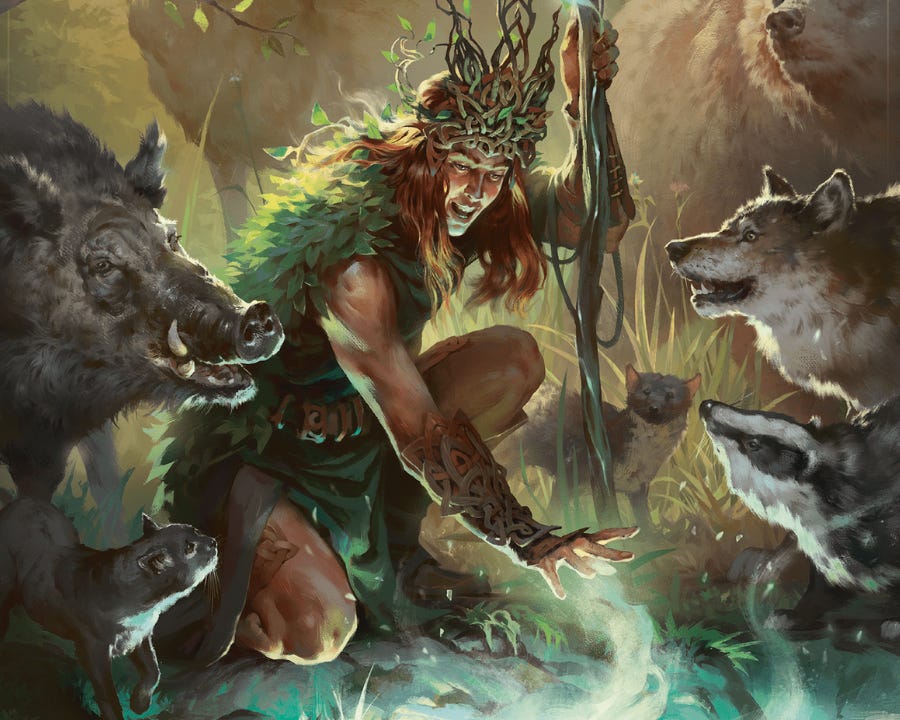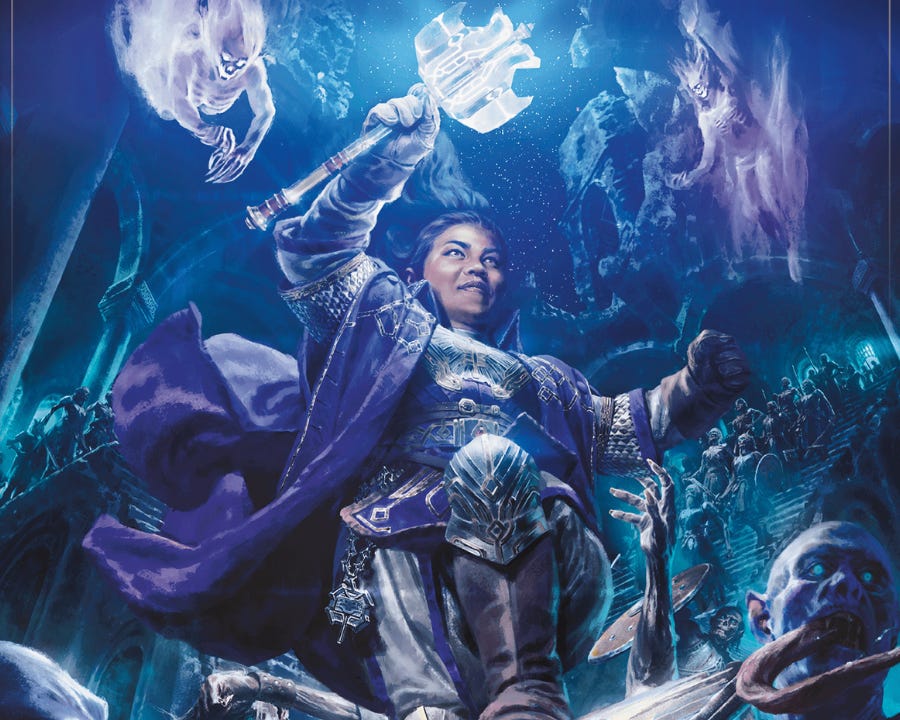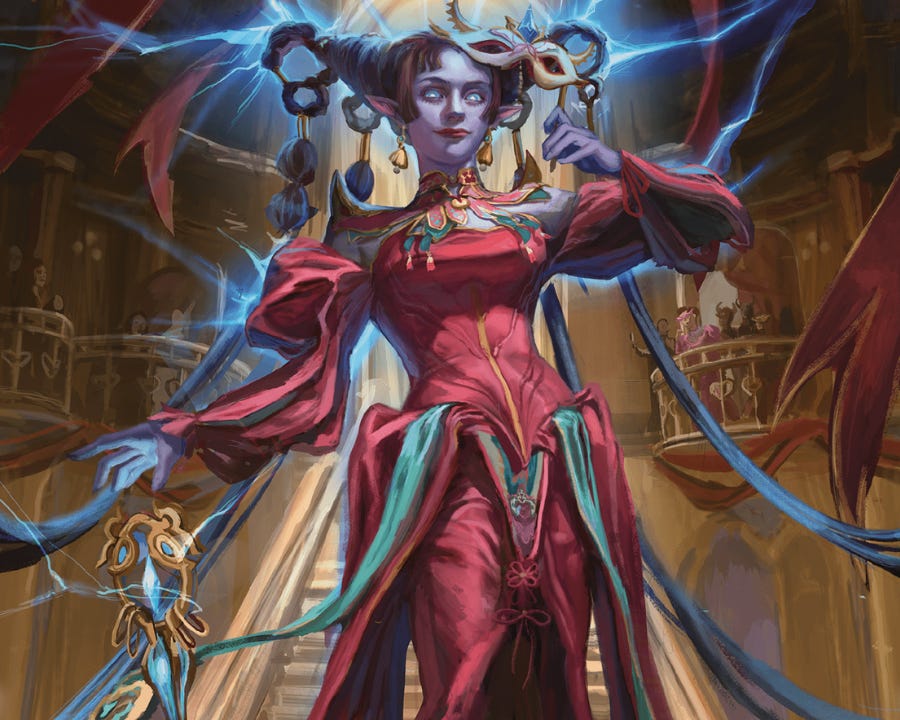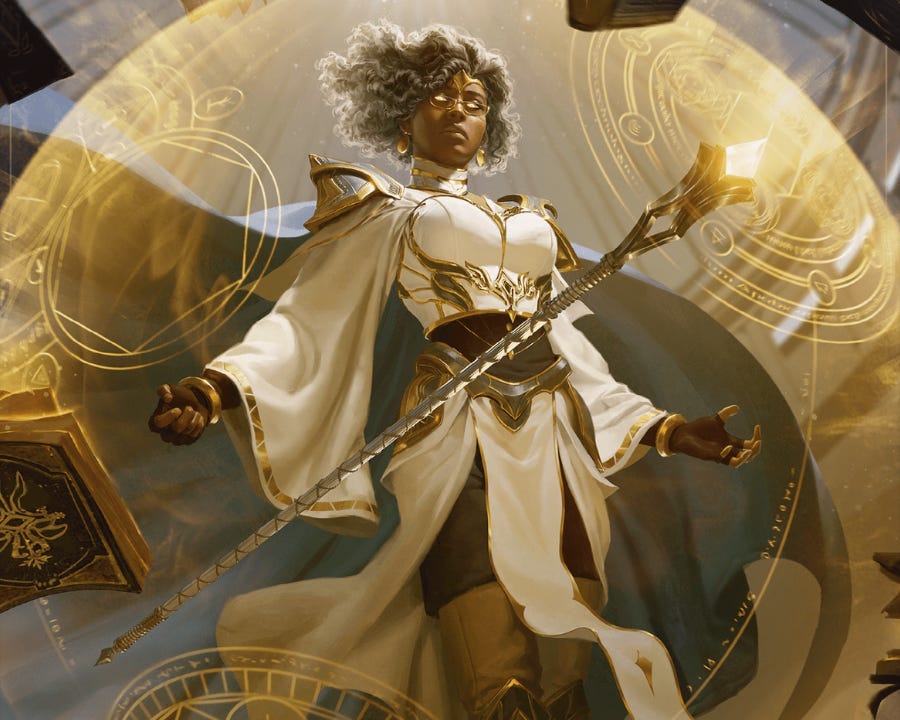Your Guide to Dungeon & Dragon's 2024 Class Overhauls
The new Player's Handbook is a game-changing update to the TTRPG we all know and love. We break down what changed — and what didn't — for the 12 core classes.
THE MIN:
The long-awaited 2024 rule update to Dungeons & Dragons dropped last week. It’s the biggest Player’s Handbook in D&D history, clocking in at a meaty 384 pages. Instead of reviewing all the changes (which range from renaming “races” to “species” to the addition of a much-needed rules glossary), we wanted to focus on what really matters to players: The classes.
Our biggest takeaways:
The new Weapon Masteries rework is a game-changer for martial classes. Every weapon now has an additional trait, such as toppling foes, knock-back effects, cleaving through multiple targets, extra damage on a miss, and granting Advantage on future strikes.
Monks and Rangers saw massive overhauls to their classes, making them more useful (and desirable) to play.
Other classes also saw reworks — many which buff core aspects of the class. Devs said they wanted to focus on utility, and the changes make sure players don’t feel left out of the game when they run out of points, chargers, or spell slots.
Each class offers four subclasses. Some of them are familiar favorites, and a few are brand new. We won’t be exploring those, but you can find more about them here.
Now, let’s take a look at what’s going on with each class – starting with those with the biggest changes:
THE MAX:
Ranger
Gone are the days when you choose a specialization that locks you into a list of features that are only useful in super-specific situations. Now, Rangers will get to know that sweet, sweet Bard-like feeling of being useful more often than not.
Hunter’s Mark is now a class-defining spell with multiple features that add extra bonuses to it … so it’s a bit of a bummer that it still requires concentration. There would be some pretty broken combos with Hunter’s Mark and other concentration spells (especially after the high-level Hunter’s Mark buffs), and you do get the free uses, so it is forgivable in my slightly biased DM opinion.
The Tireless feature at level 10 adds options to get rid of Exhaustion and grant yourself temp HP. This will be helpful against any foe in any type of environment your DM throws you into.
We now have the Favored Enemy feature that has the Hunter’s Mark spell always prepared and gives you two free uses of it per day (which scales up to six a day as you level up).
The rest of the features continue to provide some awesome utility. Rangers can benefit from how the ranged Weapon Masteries combo with other class features. The Roving trait grants extra movement speed along with swimming and climbing speeds so you can always be an adaptive force of nature. Later levels grant them full turns worth of invisibility and a permanent 30ft radius of blindsight.
These new Rangers will always be powerhouses for filling the niche of tracking enemies, leading long expeditions, and surviving out in the wild.
Monk
Do you know that one scene in the original Willy Wonka movie? When all the kids walk into the room where everything is made of candy, and Pure Imagination starts playing? The look of absolute bewilderment on their faces? I like to imagine that’s how long-time Monk players felt when looking at the new class features for the first time.
Gone are the days of useless Bonus Actions when you run out of Focus Points (renamed from Ki Points). The 2014 Monk options return with the added benefit of reduced power options being available for free.
Flurry of Blows — Offers an Unarmed Strike as a Bonus Action. Spend a Focus Point for a second. At higher levels, you can pop, pop, pop up to three additional strikes.
Patient Defense — You may always Disengage as a Bonus Action. Spend a Focus Point to Dodge as well. At higher levels, it GRANTS YOU TEMP HP!
Step of the Wind — You can always Dash as a Bonus Action. Spend a Focus Point to Disengage as well. At higher levels, it can move someone else with you and negate opportunity attacks against you or them.
Martial Arts Die—These now start at 1d6 and scale to one die level higher than the 2014 Monk.
Focus Points — Get them back on any rest. Once per long rest, while rolling initiative, you can also recharge all Focus Points and heal a decent amount.
Deflect Missiles — This has been reworked into Deflect Attacks to make it a better all-around defensive option.
At level six, you now have the option to deal Unarmed Strikes as force damage. HELLO?!?!
The buffs keep rolling in at higher levels with more options to maintain your Focus Point budget, add mobility, and solidify your defenses. This class rework is an absolute delight, and it just gets even better with the subclass options. (If you want a little laugh, watch this video and see how many times Jeremy Crawford desperately tries not to mention “Avatar: The Last Airbender” while describing the new Warrior of the Elements subclass.)
Bard
Bards will play similarly to the 2014 rules. However, there are a few key changes to note:
Inspiration — DMs, say hello to even longer lute-shredding solos. Inspiration now lasts for an hour instead of ten minutes.
Expertise — Bards now get this feature at level two, not level three.
Countercharm — Biggest buff? Say goodbye to burning your whole Action. This feature is now a Reaction you can take when you or a creature in range fails a save against being Charmed or Frightened. Countercharm lets them reroll the save with Advantage.
Magical Secrets — Bard can no longer pick from Paladin or Ranger spell lists, but the trade-off is that they now pick from the Bard, Cleric, Wizard, and Druid Spell lists on every level up. A bit of a nerf if you really wanted Aura of Vitality, but overall a nice addition to higher-level spell selections.
Words of Power — At level 20, Bards now always have Power Words Kill and Heal prepared, and you can target up to two creatures with the spell instead of being limited to one.
One of the unnoticed buffs to this class came with the Vicious Mockery cantrip’s die bumping up to a d6. It’s not too crazy, but it’s a nice bump in damage for the classic Bard spell.
This new Bard truly shines with some incredible subclass options. I’m thrilled to try out a College of Dance Bard next time I can con someone into DMing instead of me!
Druid

Druids have some interesting reworks. New specialization options allow players to lean into either physical or magical builds. Some new spell options (like the cantrip Starry Wisp) add fresh excitement to the class as well. But none of that is what we look for in a Druid class — so let’s talk about Wild Shape.
Rejoice! Every druid can now Wild Shape as a Bonus Action. Also, after level 5, you can spend a single spell slot to get another charge of Wild Shape if you run out. We love this. But one new rework is dividing Druid fans: You no longer get a pool of HP equal to your Wild Shape beast. Now, you get temp HP equal to your Druid level (x3 for Circle of the Moon Druids), and you aren’t knocked out of Wild Shape until you choose to end it, you run out of time, or you are knocked unconscious.
If you were planning on continuously Wild Shaping into large beasts to get tons of extra HP and tank every fight, then this may be a nerf at lower levels. But if you were planning on scouting out an area as a 2 HP cat or a raven, and you don’t want to be knocked out of Wild Shape because a guard shooed you away with a kick? Then huzzah! Your day has arrived!
Also of note, the Wild Companion feature. You can spend a use of Wild Shape to cast the Find Familiar spell. These animal companions make for amazing roleplay opportunities and you can make use of the spell features for some awesome added utility.
Paladin
Well … here we are, folks. Let’s talk about the Divine Smite controversy.
It is now a level one spell (available only to Paladins), and it costs a Bonus Action use. This is now basically limiting smites to once per turn, and you can’t stack it with other types of smite spells. It still costs spell slots and deals the same amount of damage per spell level used. You get one free use of it per long rest, so that’s great. Between long rests, you can deal more damage with Smite than before, but sadly, we are sacrificing the ability to go supernova on a BBG and blitz them with 3 Smites in a single turn. We are giving up our Future Trunks vs Frieza moments.
Paladins also get access to the new Weapon Masteries to expand on their combat prowess. The rest of the class features are nice improvements on past abilities. Auras work slightly better than before. Improved Divine Smite at level 11 was renamed to Divine Strikes and provides the same effect of boosting all melee strikes into diet smites. The Faithful Steed feature is wonderful, providing you with a free daily use of the Find Steed spell.
The subclass options see some familiars return with some great specializations and some truly tasty level 20 abilities.
Cleric

The new handbook is going to let you play the type of Cleric you want to play. New options allow players to lean into being a tank or a more potent spellcaster, regardless of your subclass. Later on, they can continue to specialize by boosting either their weapon or cantrip damage.
The Channel Divinity feature will now include a Divine Spark option to either harm or heal for 1d8 (scaling) plus your Wisdom modifier. The classic Turn Undead ability returns with improved functionality. Undead must attempt to save against it like before, but on a fail, creatures now gain the incapacitated status (say goodbye to creatures running 60 feet away in one turn). At higher levels, Destroy Undead is now replaced by the Sear Undead feature, which now does significant damage to all creatures that fail the save. This will still destroy low CR skeletons like before, but you now get the added joy of putting some divine hurt on that pesky lich as well.
But the biggest buff for Cleric lies in Cure Wounds and Healing Word. The number of dice for these spells has doubled at their base level. It seems like the devs are trying to make healing during combat a more viable option. It’s rarely fun for someone to spend their turn healing a party member for 6 HP only for them to get dropped again before their next turn. Let’s make healers feel good about healing when they spend a turn on it.
Fighter
Every conceivable aspect of this class has been buffed. If you are expecting to see anything in the Fighter’s abilities, it will be there, and it’s most likely better than you expected.
Second Wind? Of course! Take two uses! You can also move half your speed afterward if you feel like it.
Do you want to use an Indomitable reroll? Go for it! Add your Fighter level to the reroll’s result while you’re at it!
Fighters, at their core, function as we are used to seeing. Thanks to the new Weapon Masteries gained at level one, they now also have even more utility beyond the basic, “Ok, I hit it.” You don’t have to be a power-gamer munchkin with all the extra sourcebooks to make a fighter with some versatility on or off the battlefield. However, as a DM, I am terrified of what kind of combos the munchkins at my table could cook up with some of the subclass options here.
Barbarian
Barbarian mains rejoice! At level one, you can now use a Bonus Action to keep your Rage going during those pesky turns where nothing is within smackin’ range! And don’t worry, that’s not the only buff we got for our buffest class. Danger Sense is now a permanent Advantage on Dexterity saving throws, no requirement to see whatever danger you’re saving against.
The new Weapon Masteries open up a lot of utility to Barbarian players. It stacks well with the new Brutal Strike feature, allowing the player to choose from various effects, like staggering opponents and knocking enemies back.
Expect to see a bit more from Barbarians out of combat. A new level three feature called Primal Knowledge allows Barbarians to replace ability checks for Survival, Intimidation, Acrobatics, Stealth, and Perception with Strength checks while they are raging (and it just straight up lets you pick a new proficiency, too!). Higher levels also let you recharge all of your Rages when you roll initiative, so spend those Rages with reckless abandon! The subclass options are great, even if the new Path of the World Tree causes my inner DM to tremble in fear.
Warlock
The 2024 Warlocks will always have one extra Eldritch Invocation than the 2014 Warlock did at any given level. Yes, they even get one at level one. Additionally, every invocation that grants you the use of a spell allows you to cast it without spending a spell slot at least once. Most of them add the spell as a permanent at-will option.
You’ve always gotten your Pact Magic spell slots back during any rest, but now you have the ability to get half of them back once per long rest at level two. This gives you a taste of the fully restorative level 20 capstone ability very early on in your Warlock career.
Patron types and their various abilities still fill the role of subclasses. However, Pact types are seeing a shift here. Pact of the Blade, Pact of the Chain, and Pact of the Tome are all now available as Eldritch Invocation options. You are not limited to selecting only one of them as you level up, nor are you required to take any of them if other invocations catch your eye (but you should still totally nab at least one).
Sorcerer

Sorcerers are supposed to be defined by their incredibly potent magic. They don’t know the most spells or have the craziest range of utility with their magic, but by Mystra’s Truth, the updated class is incredibly effective at what it can do.
Starting at level one, Sorcerers get Innate Sorcery. Twice a day, they can activate this for a minute to increase their Spell Save DC by one and gain Advantage on all Spell Attack rolls they make with Sorcerer spells. That's potent. At later levels, you can spend two Sorcery Points to activate Innate Sorcery after the free uses are gone, and it adds the ability to use two Metamagic traits on one spell. That’s really potent. At level 20, it grows further to allow you to use one Metamagic feature per turn without spending ANY points. That’s really REA— you get the point.
Sorcery Points and spell slots are still exchangeable with spell slots being a bit more expensive in the conversion rates.
We’re not seeing many differences in what you can do with Metamagic, but your feature choices and subclass selection will still play a major role in defining your exact flavor of Sorcerer.
Rogue
Devs stated that their main goal for the Rogue class in the redesign was to take its wonderful pieces of design and “add some new twists.” Sneak Attack, Cunning Action, Uncanny Dodge, Evasion, Reliable Talent, Slippery Mind, Elusive, and Stroke of Luck are all available to be used in the same ways that 2014 Rogues used them. Expertise is now available at level one instead of making you wait till level six, making Rogue a lot more appealing as a multi-class dip.
Sneak Attack has some awesome improvements at level five with the new Cunning Strikes feature. You can choose to forgo 1d6 of sneak attack damage to potentially poison enemies, knock them prone, or slow their movement speeds. Even more options open up at higher levels for crazier effects at the cost of more Sneak Attack damage. Drill your enemies with as much damage as possible, or deconstruct the battlefield like a surgeon. Access to certain Weapon Masteries and the Steady Aim feature will also ensure that Rogues almost always get to use their Sneak Attacks.
Wizard

Wizards have further solidified their reputation as being the Oprah Winfreys of spells. They have access to more spells, they can learn more spells, and they can add more spells to their repertoire anytime they find new scrolls. Wizards now even get Expertise in one skill that reflects their scholarly interests.
Arcane Recovery makes its return as the classic option to get a little more juice out of the tank once a day. After level five, Wizards will also be able to swap out a prepared spell for another in their book, thanks to the new Memorize Spell feature.
The subclasses continue their role in letting Wizards specialize in specific schools of magic while granting some unique abilities in those fields. New spells and some key changes to certain spells and cantrips could also have some pretty major impacts on Wizards that I have yet to fully unpack (Jallarzi’s Storm of Radiance sounds amazing!).










